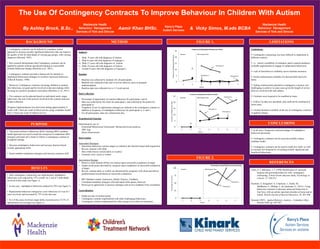
Using Contingency Contracts to Improve Behaviors in Children with Autism
- 1. printed by www.postersession.com The Use Of Contingency Contracts To Improve Behaviour In Children With Autism By Ashley Brock, B.Sc., Aamir Khan BHSc. & Vicky Simos, M.ads BCBA • Contingency contracts can be utilized in a mediator model approach to increase socially significant behaviours that can improve the quality of life for individuals of varying age groups, with varying diagnoses (Heward, 1987). • Past research demonstrates that Contingency contracts can be applied by parents without specialized training to successfully promote behaviour change (Hawkins et al., 2011). • Contingency contracts provide a framework for families to implement behavioural strategies to reinforce and teach behaviour (Allen & Kramer, 1990). • Moreover, Contingency contracts encourage children to monitor their behaviour, set goals and be involved in decision making while focusing on a positive productive procedure (Hawkins et al., 2011) . • The contracts can be adjusted based on individual needs, target behaviours, the role of the persons involved in the contract and ease of data collection. •Program implementation was short term lasting approximately 8 weeks with 1 hour per week of direct service using a mediator model and 2-3 hours per week of indirect service. Subjects i. Male 9 years old with diagnosis of Autism ii. Male 8 years old with diagnosis of Asperger’s iii. Male 13 years old with diagnosis of Autism iv. Male 18 years old with diagnosis of Autism v. Female 8 years old with diagnosis of Asperger’s Baseline • Baseline was collected by mediator for all participants. • Baseline was collected at the start of service delivery, prior to program implementation. • Baseline data was collected over a 1-2 week period. Data Collection • Percentage of opportunity of contract adherence for participant i and iii • Data was collected by the client for participant i, and collected by the parent for participant iii • Frequency of use of replacement strategies as outlined in the contingency contract in addition to frequency of maladaptive behaviour for participants ii, iv and v. • For all participants, data was collected per day. Hypothesized Function Determined by use of : Functional Behavioural Assessment: Bio/psycho/social analysis, ABC logs Direct observations Intervention Antecedent Strategies • Determine behaviour contract targets as related to the function based skill acquisition • Review contract with child • Have child choose reward (daily or weekly) • Contracts were visual or written Intervention Strategy • Parent or child marked off box on contract upon successful completion of target • Ample social praise provided by caregiver upon completion of successful completion of target • Review contract daily or weekly (as determined by program) with client and deliver predetermined reward based on successful completion. • BST Mediator model; Instruction, Model, Practice, Feedback • Consultant modelled strategies with individual while parent observed • Parent given opportunity to practice strategies and receive feedback from consultants Generalization • Faded out rate of reinforcement • Contingency contract implemented with other challenging behaviours • Contingency contract implemented by other caregivers/in other environments BACKGROUND PURPOSE METHOD RESULTS LIMITATIONS REFERENCES Limitations: Contingency contracting was more difficult to implement in different contexts. i.e. school, availability of mediators and/or trained mediators, available opportunities to engage in replacement behaviours. Lack of Interobserver reliability across baseline measures. Initial reinforcement schedules for desired skills had to be dense. Fading reinforcement attached to contingency contracts was challenging to achieve in some cases given the length of service delivery involved with each subject. Contracts were required to be modified at times. Follow-Up data was anecdotal, and could not be confirmed in some cases. Limited literature available on the use of contingency contracts in applied settings. • This poster outlines a Behaviour Skills Training (BST) mediator model approach was used to teach the caregivers to implement ABA strategies and teach all 5 clients to follow a contingency contract in an applied settings. • Decrease maladaptive behaviours and increase function based socially appropriate skills. • Teach mediator implement strategies and increase caregiver skill. • After contingency contracting was implemented, maladaptive behaviours were reduced by 57% overall for 3 out of 5 individuals involved in this study (see figure 1). • In one case, maladaptive behaviour reduced by 92% (see figure 1). • Replacement behaviour emerged as a new behaviour in 4 out of 5 cases involved, and increased by 73% in the last case. • In 2 of the cases involved, target skills occurred across 73.5% of opportunities (on average) (see figure 2). Allen, S. J. &Kramer, J. J. (1990) Modification of personal hygiene and grooming behaviors with contingency contracting: A brief review and case study. Psychology in schools, 27, 244-251. Hawkins. E, Kingsdorf, S., Charnock, J., Szabo, M., Middleton, E., Phillips, J., & Gautreaux G. (2011). Using behaviour contracts to decrease antisocial behaviour in four boys with an autistic spectrum disorder at home and at school. British Journal of Special Education, 38, 201-208. Heward (1987). Applied Behavior Analysis. Columbus, Ohio: Prentice Hall, pp. 467-485 FIGURE 2. FIGURE 1. In all cases, frequencies and percentages of maladaptive behaviour decreased. Contingency contracts can be used successfully using a mediator model. Contingency contracts can be used to teach new skills, as well as increase low frequencies of existing socially significant and beneficial behaviours. CONCLUSIONS
